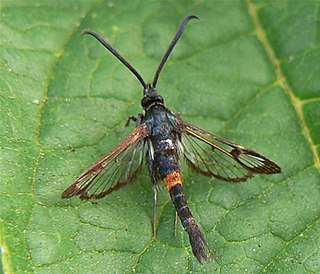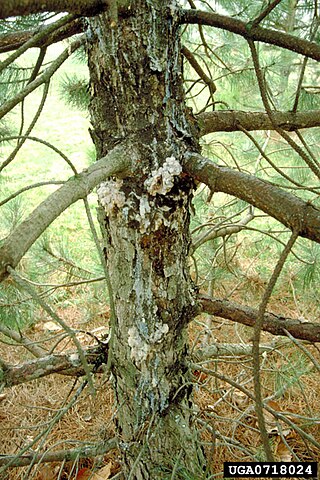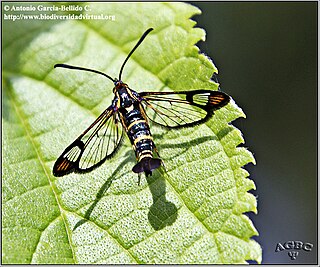
Synanthedon culiciformis, known as the large red-belted clearwing, is a moth of the family Sesiidae. It is found in the Palearctic and Nearctic realms.

Synanthedon myopaeformis is a moth of the family Sesiidae and the order Lepidoptera. In Europe it is known as the red-belted clearwing and in North America as the apple clearwing moth. The larvae create galleries under the bark of fruit trees, especially old trees with damaged trunks. During this process, the larvae cause significant damage to host trees. Particular attention has been paid to the damage they cause to apple trees. Their status as a pest of apple orchards has led to many research projects aimed at controlling populations of the moth. This moth is native to Europe, the Near East and North Africa. Recently, the moth was introduced into North America, being first detected in Canada in 2005. There are several organisms that threaten the larvae, including parasitoids, nematodes, and bacteria.

Synanthedon tipuliformis, known as the currant clearwing, is a moth of the family Sesiidae. It is endemic to the Palearctic realm, but is an invasive species in the Nearctic realm and the Australasian realm.

Synanthedon vespiformis, the yellow-legged clearwing, is a moth of the family Sesiidae. It is found in the Palearctic realm.

Synanthedon exitiosa, the peachtree borer, is a species of moth in the family Sesiidae that is native to North America.

Synanthedon bibionipennis, the strawberry crown moth, is a moth of the family Sesiidae. It is found in western North America from Montana south to Texas westward to the Pacific coast and from British Columbia to California. It is an introduced species in Hawaii.

Synanthedon andrenaeformis, the orange-tailed clearwing, is a moth of the family Sesiidae. It is known from most of Europe. It is also present in the Near East.

Synanthedon scitula, the dogwood borer or pecan borer, is a moth that is a pest of many plants including the dogwood and pecan. It is notorious due to the severity of damage it can cause and its widespread geographical distribution.

Synanthedon pictipes, the lesser peachtree borer, is a moth of the family Sesiidae. It is known from the eastern half of Canada and the United States westward to Minnesota in the north and eastern Texas in the south.

Synanthedon pini, the pitch mass borer, is a moth of the family Sesiidae. The pitch mass borer occurs on spruce and pine in eastern North America. It does not kill trees, but the pitch-filled larval tunnels in the wood cause defects in the lumber.

Synanthedon rileyana, the horsenettle borer or Riley's clearwing moth, is a moth of the family Sesiidae. It is found in the United States, including Arkansas, Arizona, Missouri, Oklahoma, North Carolina and Pennsylvania.
The term pitch moth refers to certain small moths whose caterpillars feed on pines. The feeding action causes the pine tree to shed its resin, which forms pitch-like masses on and under the tree. There are several species of "pitch moths" and not all are closely related:

Synanthedon formicaeformis, the red-tipped clearwing, is a moth of the family Sesiidae and can be found in all of Europe, the eastern Palearctic realm, and the Near East. The larvae sometimes form pear-shaped galls on willows. It was first described by Eugenius Johann Christoph Esper in 1783.

Synanthedon stomoxiformis is a moth of the family Sesiidae. It is found in most of Europe and the Middle East.

Synanthedon cephiformis is a moth of the family Sesiidae. It is found in Central Europe and Eastern Europe.

Synanthedon conopiformis, Dale's oak clearwing, is a moth of the family Sesiidae. It is found in almost all of Europe, except the north.
Synanthedon flaviventris, the sallow clearwing, is a moth of the family Sesiidae. The larvae form pear-shaped galls on sallows.
Synanthedon mesiaeformis is a moth of the family Sesiidae. It is found in France, Spain, Lithuania, Poland, the Czech Republic, most of the Balkan Peninsula, Finland, Russia and Asia Minor. The species prefers solitary trees on meadows, in parks and along streams.

Synanthedon scoliaeformis, the Welsh clearwing, is a moth of the family Sesiidae. It is found from almost all of Europe, east through Russia to Japan.

Synanthedon spuleri is a moth of the family Sesiidae. It is found from France to Turkey and Georgia. In the south, it is found in southern and eastern Europe. In the north, the range extends to the line Paris-southern Germany.

















